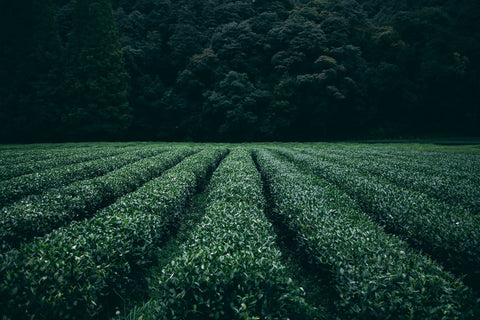News
Ready for a healthy boost? January 26 2016
I recently met the talented Fi Jamieson-Folland and we got talking - about tea and about health. We decided to team up; to combine that into a blog piece about the benefits of tea. As a qualified osteopath, certified raw vegan, gluten-free chef, educator, writer and health mentor, Fi is well and truly qualified on the topic of health and wellness! I'll let Fi take it away below...
What if there's a way to give ourselves a daily dosing of antioxidants, that's been trusted and true for millions of people for over 3000 years? And what if this healthy solution is for an investment of just a few minutes and a couple of cents?
Alright - so I hear you asking ‘what is this wonder-boost, how does it work and how can I get it?’
Some of you will have guessed it - given that the lovely Katie Smith has asked me to contribute a few healthy, top tips for her Ritual Tea Company blog.
Yes, it's green tea.

Originally trusted by both villagers and health practitioners, where the leaves were originally chewed in Southwest China, green tea is now a mainstream and refreshing beverage and even a restorative ingredient in many health tonics and beauty products.
So what's so good about green tea?
This unassuming small leaf is packed with a veritable smorgasbord of agents offering potential health benefits; varying from protecting our cells to helping maximize our daily productivity.
Check out this impressive list of possible perks from your daily green tea cuppa:
- The natural form of caffeine combined with the L-theanin, can help to improve brain function, boost mood and energy levels.
- Some studies show increased metabolic rate, mild reductions in circulating blood sugar, and increased fat burning activity of our cells.
- The catechins can help with dental health and reduce infection.
- The powerful antioxidants may protect our cells from damage from a variety of damage including cancer, Alzheimer’s, Parkinson’s, type II diabetes and heart disease.
It tastes good too!
Heating your water to the optimal temperature (just below boiling before you pour over your leaves) will draw out the right balance of amino acids, which give the flavour and sweetness - plus tannins, which give astringency.
And after only one minute of steeping in your favourite teapot or cup, the active ingredients will be busy doing their thing.
If you like the sound of the potential benefits of this humble leaf, check out the green teas in the Ritual range here.
And if having more energy, being more focused and productive in your day sounds interesting, then drop me a line at fi@fijamiesonfolland.com. A FREE Alignment session maybe just the thing for you :)
Fi Jamieson-Folland D.O, is an Executive Lifestyle Consultant, with over 20 years experience in Europe, Asia and New Zealand as a qualified osteopath, certified raw vegan, gluten-free chef, educator, writer and health mentor. She lives in New Zealand and Indonesia with her husband Chris, relishing an outdoor lifestyle and time with family and friends.

Why people who hate green tea are probably doing it wrong November 20 2015

When I tell people that I blend tea, quite a few people have told me they hate green tea; that it's just too bitter. I try not to sound like a know-it-all-hyper-excited-about-tea-nerd and explain that this may be because of the type of tea they are using or the way they’re brewing their tea.
Here are three things you should watch out for when you brew a cup of green tea:
The quality of your tea
If you grab a pack of 50 green tea bags from the local supermarket for $2.50, the quality isn't going to be the best. That doesn't mean you need to splash out on Tieguanyin tea (a Chinese oolong selling at a cool $3,000 per kg), but a whole leaf tea will do the trick, at around $10 a pack.
Tea comes in different grades, according to the size and quality of the leaf. The stuff in those $2.50 tea bags is called ‘fannings’ or ‘dust’. Sometimes joked about (well, I hope it's a joke) is that fannings are what they sweep off the floor of the tea factory. Not ideal! The grade of tea we use at Ritual Tea Company is 'orange pekoe'; a quality, whole leaf. After you have brewed a cup of Ritual, you will notice that the dried leaves have unfurled to reveal a whole leaf. A whole leaf means you get great flavour and health benefits, without the bitterness.
The temperature of the water
The other reason green tea can taste bitter is the water. Please do not pour boiling water on your tea leaves. This burns them. For green tea, the water should be at about 80 degrees celcius. If you don’t have a kettle that boils your water to specific temperatures (yes, they exist!) then you can boil your jug and leave it to cool for a few minutes (3-5 should do the trick). Water that is just below a boil (97 degrees, to be specific), is perfect for a black tea. Green tea is more delicate than black tea, hence the difference in temperature.
How long you leave your tea to steep
Watch the amount of time you leave your tea to steep. I recommend one minute for a green tea. Anything longer means the brew can end up tasting bitter. Start taking note of the colour of your brews as well. The colour differs from tea to tea, but if you brew the same type of tea often, it can be a great indicator of whether the tea is brewed the way you like it.
Try it out and come up with a ritual that works best for you! I'd love to hear if these tips help you get the best out of your cup of tea, or if you've got any more tips.
Katie
Founder, Ritual Tea Company
